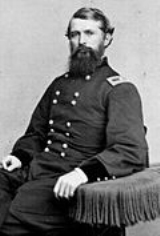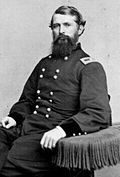
Battle of Blue Springs
Encyclopedia

American Civil War
The American Civil War was a civil war fought in the United States of America. In response to the election of Abraham Lincoln as President of the United States, 11 southern slave states declared their secession from the United States and formed the Confederate States of America ; the other 25...
, occurring on October 10, 1863, in Greene County, Tennessee.
Maj. Gen.
Major General
Major general or major-general is a military rank used in many countries. It is derived from the older rank of sergeant major general. A major general is a high-ranking officer, normally subordinate to the rank of lieutenant general and senior to the ranks of brigadier and brigadier general...
Ambrose E. Burnside, commander of the Department of the Ohio
Department of the Ohio
The Department of the Ohio was an administrative military district created by the United States War Department early in the American Civil War to administer the troops in the Northern states near the Ohio River.General Orders No...
, undertook an expedition into East Tennessee
East Tennessee
East Tennessee is a name given to approximately the eastern third of the U.S. state of Tennessee, one of the three Grand Divisions of Tennessee defined in state law. East Tennessee consists of 33 counties, 30 located within the Eastern Time Zone and three counties in the Central Time Zone, namely...
to clear the roads and passes to Virginia
Virginia
The Commonwealth of Virginia , is a U.S. state on the Atlantic Coast of the Southern United States. Virginia is nicknamed the "Old Dominion" and sometimes the "Mother of Presidents" after the eight U.S. presidents born there...
, and, if possible, secure the saltworks beyond Abingdon
Abingdon, Virginia
Abingdon is a town in Washington County, Virginia, USA, 133 miles southwest of Roanoke. The population was 8,191 at the 2010 census. It is the county seat of Washington County and is a designated Virginia Historic Landmark...
. In October, Confederate
Confederate States Army
The Confederate States Army was the army of the Confederate States of America while the Confederacy existed during the American Civil War. On February 8, 1861, delegates from the seven Deep South states which had already declared their secession from the United States of America adopted the...
Brig. Gen.
Brigadier General
Brigadier general is a senior rank in the armed forces. It is the lowest ranking general officer in some countries, usually sitting between the ranks of colonel and major general. When appointed to a field command, a brigadier general is typically in command of a brigade consisting of around 4,000...
John S. Williams
John Stuart Williams
John Stuart Williams was a general in the Confederate States Army during the American Civil War and a postbellum Democratic U.S. Senator from Kentucky.-Early life and career:...
, with his cavalry force, set out to disrupt Union
Union Army
The Union Army was the land force that fought for the Union during the American Civil War. It was also known as the Federal Army, the U.S. Army, the Northern Army and the National Army...
communications and logistics. He wished to take Bulls Gap on the East Tennessee & Virginia Railroad. On October 3, while advancing on Bulls Gap, he fought with Brig. Gen. Samuel P. Carter
Samuel P. Carter
Samuel Perry "Powhatan" Carter was a United States naval officer who served in the Union Army as a brevet major general during the American Civil War and became a rear admiral in the postbellum United States Navy. He was the first and thusfar only United States officer to have been commissioned...
's Union Cavalry Division, XXIII Corps
XXIII Corps (ACW)
XXIII Corps was a corps of the Union Army during the American Civil War. It served in the Western Theater as part of the Army of the Ohio.The corps was organized in April 1863 by order of the departmental commander, Ambrose E. Burnside...
, at Blue Springs, about nine miles from Bulls Gap, on the railroad. Carter, not knowing how many of the enemy he faced, withdrew.
Carter and Williams skirmished for the next few days. On October 10, Carter approached Blue Springs in force. Williams had received some reinforcements. The battle began about 10:00 a.m. with Union cavalry engaging the Confederates until afternoon while another mounted force attempted to place itself in a position to cut off a Confederate retreat. Captain Orlando M. Poe, the Chief Engineer, performed a reconnaissance to identify the best location for making an infantry attack. At 3:30 pm, Brig. Gen. Edward Ferrero
Edward Ferrero
Edward Ferrero was one of the leading dance instructors, choreographers, and ballroom operators in the United States. He also served as a Union Army general in the American Civil War, best remembered for his role in the Battle of the Crater in 1864.-Early life and career:Ferrero was born in...
's 1st Division, IX Corps
IX Corps (ACW)
IX Corps was a corps of the Union Army during the American Civil War that distinguished itself in combat in multiple theaters: the Carolinas, Virginia, Kentucky, Tennessee, and Mississippi.-Formation, Second Bull Run, and Antietam:...
, moved up to attack, which he did at 5:00 p.m. Ferrero's men broke into the Confederate line, causing heavy casualties, and advanced almost to the enemy's rear before being checked. After dark, the Confederates withdrew and the Federals took up the pursuit in the morning. Within days, Williams and his men had retired to Virginia. Burnside had launched the East Tennessee Campaign to reduce or extinguish Confederate influence in the area; Blue Springs helped fulfill that mission.

